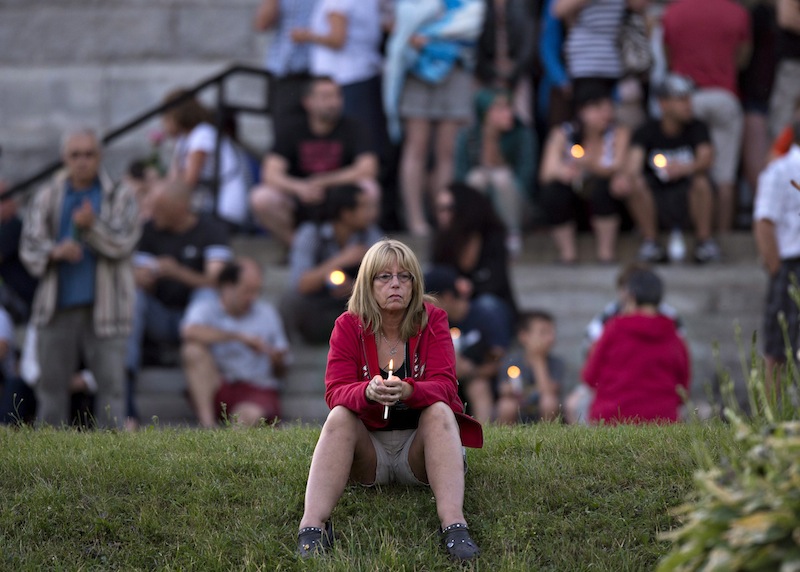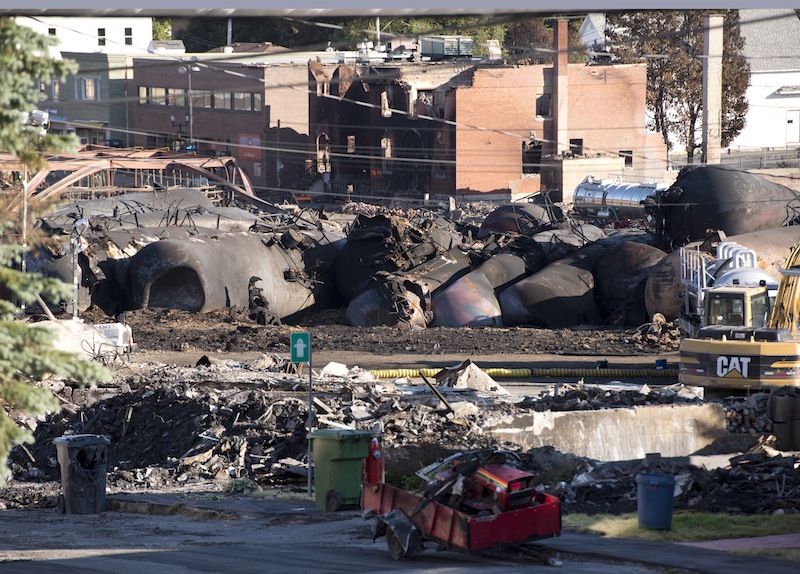Transportation workers moved carefully Friday in and around the site of the nearly week-old derailment that incinerated the heart of this small Quebec town and killed 50 people, searching for evidence that would help explain what led to such massive destruction.
Police, meanwhile, increased the number of people confirmed killed by four to 28 as the search for remains continued to be slowed by dangerous conditions — this time it was benzene fumes from the contaminated soil, which forced officials to try to ventilate the area. The other 22 people are presumed dead.
Information and material being put together by investigators includes the track’s grade, the train’s weight and how many brakes were set shortly before the locomotive and 72 tankers carrying shale oil began rolling down a slope in the early hours of Saturday, gathering speed for seven miles (11 kilometers) before slamming into the downtown of Lac-Megantic. The crash and ensuing explosions destroyed homes, businesses, a municipal library and the popular Musi-Cafe bar that was filled with people.
“I keep coming back to the Musi-Cafe because I have two children in their 20s and they could have easily been at a bar like that,” said Wendy Tadros, chairwoman of Canada’s Transportation Safety Board. “I’m sorry I cannot do more to relieve your grief.”
It will be months or longer before investigators will be able to draw any conclusions about what happened, Tadros said. Investigators plan to produce a 3D model through laser scanning of images being collected at the scene of the disaster.
Edward Burkhardt, president and CEO of U.S.-based Rail World Inc., which owns the runaway train, has blamed the engineer for failing to set the brakes on the train, which came from North Dakota.
Burkhardt said the engineer had been suspended without pay and was under “police control.” Burkhardt did not name the engineer, though the company had previously identified the employee as Tom Harding of Quebec. Harding has not spoken publicly since the crash.
The devastated downtown remained dangerous all week as responders put out fires and struggled to keep the remaining oil tankers cool so they wouldn’t explode. The hazardous conditions delayed the search for remains, which were burned so badly that coroners have been able to identify only eight bodies so far.
The first victim to be named by the coroner’s office Thursday was 93-year-old Eliane Parenteau. Officials did not release the names of the other seven Friday, saying their families had not been notified yet.
Earlier Friday, mourners gathered in a church near the crash site. Around town, flags flew at half-mast and small, impromptu memorials dotted the landscape. A candlelight vigil planned for Friday night was canceled after police said they didn’t have the resources to oversee large crowds.
The derailment is Canada’s worst railway disaster since a train plunged into a Quebec river in 1864, killing 99.
The crash has raised questions about the rapidly growing use of rail to transport oil in North America, especially in the booming North Dakota oil fields and Alberta oil sands far from the sea.
Copy the Story LinkSend questions/comments to the editors.





Success. Please wait for the page to reload. If the page does not reload within 5 seconds, please refresh the page.
Enter your email and password to access comments.
Hi, to comment on stories you must . This profile is in addition to your subscription and website login.
Already have a commenting profile? .
Invalid username/password.
Please check your email to confirm and complete your registration.
Only subscribers are eligible to post comments. Please subscribe or login first for digital access. Here’s why.
Use the form below to reset your password. When you've submitted your account email, we will send an email with a reset code.